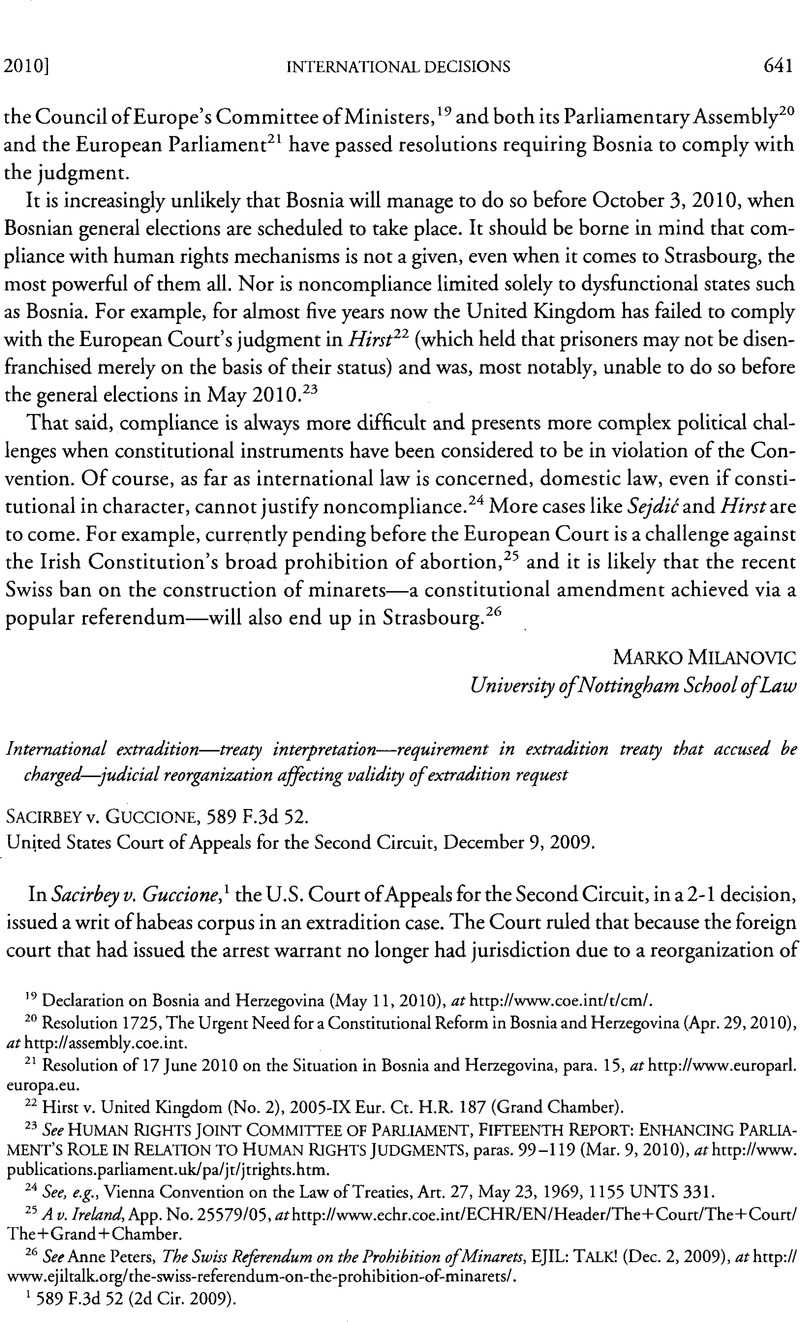No CrossRef data available.
Article contents
Sacirbey v. Guccione, 589 F.3d 52. United States Court of Appeals for the Second Circuit, December 9, 2009
Published online by Cambridge University Press: 27 February 2017
Abstract

- Type
- International Decisions
- Information
- Copyright
- Copyright © American Society of International Law 2010
References
1 589 F.3d 52 (2d Cir. 2009).
2 Treaty for Mutual Extradition of Fugitives from Justice, U.S.-Serbia, Mar. 7, 1902, 32 Stat. 1890, 12 Bevans 1238.
3 See In re Sacirbegovic, 2005 U.S. Dist. LEXIS 707 (S.D.N.Y. Jan. 18, 2005).
4 See Sacirbey v. Guccione, 2006 U.S. Dist. LEXIS 64577 (S.D.N.Y. Sept. 7, 2006).
5 See In re Assarsson, 635 F.2d 1237,1242-44 (7th Cir. 1980), cert, denied, Ail U.S. 938 (1981);In re Assarsson, 687 F.2d 1157,1159-60 (8th Cir. 1982); Emami v. United States District Court, 834 F.2d 1444, 1448-49 (9th Cir. 1987).
6 290 U.S. 276 (1933).
7 Id. at 293-94. Accord, Valentine v. United States ex rel. Neidecker, 299 U.S. 5, 10 (1936).
8 Shapiro v. Ferrandina, 478 F.2d 894, 904 (2d Cir.), cert, dismissed, 414 U.S. 884 (1973) (quoting Bingham v. Bradley, 241 U.S. 511, 517 (1916)); see also Escobedo v. United States, 623 F.2d 1098, 1104 (5th Cir.), cert, denied, 449 U.S. 1036 (1980).
9 In re Assarsson, 635 F.2d 1237, 1242 (7th Cir. 1980), cert, denied, 451 U.S. 938 (1981).
10 May 23, 1969, 1155 UNTS 331.
11 See Chubb & Son, Inc. v. Asiana Airlines, 214 F.3d 301, 309 (2d Cir. 2000) (“We. . . treat the Vienna Convention as an authoritative guide to the customary international law of treaties.”), cert, denied, 533 U.S. 928 (2001); id. at 308-09 (collecting cases).
12 Vienna Convention on the Law of Treaties, supra note 10, Art. 31(1).
13 Preamble, Treaty for Mutual Extradition of Fugitives from Justice, U.S.-Serbia, Mar. 7, 1902,32 Stat. 1890, 12 Bevans 1238. The preamble of a treaty is part of the context that is taken into account in interpreting the treaty. See Restatement (Third) of the Foreign Relations Law of the United States §325, cmt. (b) (1987)Google Scholar; Vienna Convention on the Law of Treaties, supra note 10, Art. 31 (2). The word “fugitive” in the U.S.-Serbia Treaty encompasses anyone sought for prosecution by the requesting country. See In re Sacirbegovic, 280 F.Supp.2d 81, 86 (S.D.N.Y. 2003) (citing cases).
14 See Cherif Bassiouni, M., International Extradition: United States Law and Practice 134-35 (5th ed. 2007)Google Scholar.
15 See, e.g., Meliav. United States, 667 F.2d 300,303 (2dCir. 1981); In re Assarsson, 635 F.2dat 1244; Emami v. United States District Court, 834 F.2d 1444,1449 (9th Cir. 1987); Sainez v. Venables, 588 F.3d 713,717 (9th Cir. 2009); In re Skaftouros, 643 F.Supp.2d 535, 546 (S.D.N.Y. 2009).
16 187 U.S. 181 (1902).
17 Id. at 190 (quoting Extradition Treaty, U.S.-Russia, June 5, 1893, Art. VI, 28 Stat. 1071).
18 Id. at 191.
19 Id. at 191-92 (dictum) (citing Rev. Stat. §5270 (1878)) (citation omitted).
20 Id. at 191.
21 See Whitney v. Robertson, 124 U.S. 190, 194 (1888) (if a treaty and a statute “are inconsistent, the one last in date will control the other”).
22 229 U.S. 447 (1913).
23 Id. at 463-64.
24 Id.
25 Compare In re Extradition of Harusha, 2008 U.S. Dist. LEXIS 28812, at *19-23 (E.D. Mich. Apr. 9, 2008) (expressly following Grin, and holding that statutory requirements overrode those of pertinent treaty), with Greci v. Birknes, 527 F.2d 956,960 (1st Cir. 1976) (“the treaty, being both more recent and more specific than the statute, provides the controlling requirements”). See also Bassiouni, supra note 14, at 112 (“Because extradition treaties and federal legislation regarding extradition carry the same weight and force, conflict between the two raises difficult questions of judicial interpretation and enforcement.”).
26 18 U.S.C. §3184.
27 18 U.S.C. §3184 was enacted in 1948. See Act of June 25, 1948, 80th Cong., 2d Sess., Ch. 645, 62 Stat. 822. It is a multigenerational successor to an 1848 statute. See Act of Aug. 12, 1848, Ch. 167, §5, 9 Stat. 302.
28 Sacirbey v. Guccione, 2006 U.S. Dist. lexis 64577, at *11-14 (S.D.N.Y. Sept. 7, 2006); In re Sacirbegovic, 2005 U.S. Dist. lexis 707, at *19-24 (S.D.N.Y. Jan. 18, 2005).
29 These issues may be considered only by the secretary of state, who makes the decision whether or not to extradite following certification by the judiciary. See Ahmad v. Wigen, 910 F.2d 1063, 1067 (2d Cir. 1990); Eain v. Wilkes, 641 F.2d 504, 508, 513, 518 (7th Cir.), cert, denied, 454 U.S. 894 (1981). See generally Jacques, Semmelman, Federal Courts, the Constitution, and the Rule of Non-inquiry in International Extradition Proceedings, 76 Cornell L. Rev. 1198 (1991)Google Scholar.


